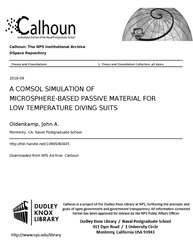File:A COMSOL SIMULATION OF MICROSPHERE-BASED PASSIVE MATERIAL FOR LOW TEMPERATURE DIVING SUITS (IA acomsolsimulatio1094560445).pdf

Original file (1,275 × 1,650 pixels, file size: 1.26 MB, MIME type: application/pdf, 72 pages)
Captions
Captions
Summary[edit]
| A COMSOL SIMULATION OF MICROSPHERE-BASED PASSIVE MATERIAL FOR LOW TEMPERATURE DIVING SUITS
( |
||
|---|---|---|
| Author |
Oldenkamp, John A. |
|
| Title |
A COMSOL SIMULATION OF MICROSPHERE-BASED PASSIVE MATERIAL FOR LOW TEMPERATURE DIVING SUITS |
|
| Publisher |
Monterey, CA; Naval Postgraduate School |
|
| Description |
The United States Navy conducts diving operations in various places and climates all over the world. The neoprene wet suit protects the diver from cold water temperatures, extending the duration the diver can stay in the water. Neoprene is a soft material made of air-foamed rubber that uses small, flexible air pockets to thermally insulate a diver from the cold. However, as the diver descends, increased ambient pressure compresses the neoprene, decreasing its thickness and shrinking its air pockets. As a result, the suit’s insulation capability significantly degrades with depth, adversely affecting diver operations and persistence time at depth. One potential solution is the use of rigid glass microspheres as the thermally insulating material, which should be impervious to pressure changes associated with diving depth. This thesis develops a model using COMSOL Multiphysics software that can be used to theoretically verify previous work and provide the framework for computer simulations to predict the thermal resistivity of various materials as a function of microsphere composition, steric distribution, and volumetric fraction within the carrier polymer. Subjects: diver; insulation; thermal; composite; material; microspheres; silicone; protection; divesuit; diving; safety; hypothermia |
|
| Language | English | |
| Publication date | September 2018 | |
| Current location |
IA Collections: navalpostgraduateschoollibrary; fedlink |
|
| Accession number |
acomsolsimulatio1094560445 |
|
| Source | ||
| Permission (Reusing this file) |
This publication is a work of the U.S. Government as defined in Title 17, United States Code, Section 101. Copyright protection is not available for this work in the United States. | |
Licensing[edit]
| Public domainPublic domainfalsefalse |
This work is in the public domain in the United States because it is a work prepared by an officer or employee of the United States Government as part of that person’s official duties under the terms of Title 17, Chapter 1, Section 105 of the US Code.
Note: This only applies to original works of the Federal Government and not to the work of any individual U.S. state, territory, commonwealth, county, municipality, or any other subdivision. This template also does not apply to postage stamp designs published by the United States Postal Service since 1978. (See § 313.6(C)(1) of Compendium of U.S. Copyright Office Practices). It also does not apply to certain US coins; see The US Mint Terms of Use.
|
 | |
| This file has been identified as being free of known restrictions under copyright law, including all related and neighboring rights. | ||
https://creativecommons.org/publicdomain/mark/1.0/PDMCreative Commons Public Domain Mark 1.0falsefalse
File history
Click on a date/time to view the file as it appeared at that time.
| Date/Time | Thumbnail | Dimensions | User | Comment | |
|---|---|---|---|---|---|
| current | 22:05, 13 July 2020 |  | 1,275 × 1,650, 72 pages (1.26 MB) | Fæ (talk | contribs) | FEDLINK - United States Federal Collection acomsolsimulatio1094560445 (User talk:Fæ/IA books#Fork8) (batch 1993-2020 #5277) |
You cannot overwrite this file.
File usage on Commons
The following page uses this file:
Metadata
This file contains additional information such as Exif metadata which may have been added by the digital camera, scanner, or software program used to create or digitize it. If the file has been modified from its original state, some details such as the timestamp may not fully reflect those of the original file. The timestamp is only as accurate as the clock in the camera, and it may be completely wrong.
| Short title | A COMSOL SIMULATION OF MICROSPHERE-BASED PASSIVE MATERIAL FOR LOW TEMPERATURE DIVING SUITS |
|---|---|
| Image title | |
| Author | Oldenkamp, John A. |
| File change date and time | 07:41, 15 October 2018 |
| Date and time of digitizing | 05:04, 12 September 2018 |
| Date metadata was last modified | 07:41, 15 October 2018 |
| Software used | Acrobat PDFMaker 11 for Word |
| Conversion program | Adobe PDF Library 11.0 |
| Encrypted | no |
| Page size | 612 x 792 pts (letter) |
| Version of PDF format | 1.4 |

